This being the case; when we find the great nations of the world, both past and present, worshipping black gods, then we logically conclude that these peoples are either members of the black race, or that they originally received their religion in toto or in part from black people.1
Gods of India
The ancient gods of India are shown with Ethiopian crowns on their heads.1
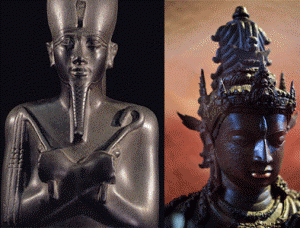
The Brahma Samhita is a Sanskrit Pancaratra text composed of verses of prayer spoken by Brahma glorifying the supreme Lord Krishna or Govinda at the beginning of creation.
The lyrics, chapter 5 verse 38 reads: “I worship Govinda, the primeval Lord, who plays on His transcendental flute. His eyes are like lotus flowers, He is decorated with peacock plumes, and His bodily color resembles the color of a fresh black cloud, although His bodily features are more beautiful than millions of Cupids.”
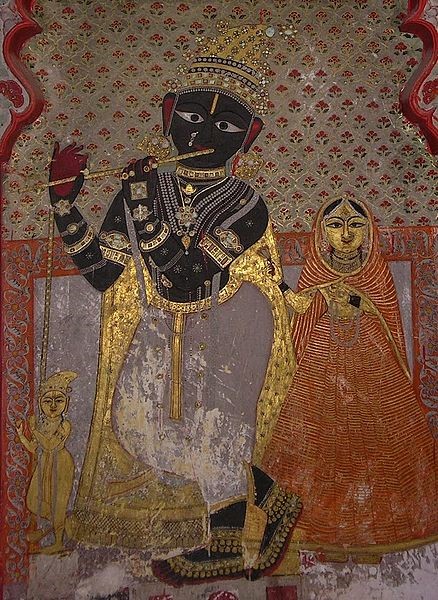
Chapter 6, verses 1-2 reads: “The Lord was dressed in yellow garments and had a blackish complexion.”
The Sanskrit word “Krishna” has the literal meaning “black,” “dark” or “dark-blue.” Krishna is also called “Śyāma,” the blackish one, or the beautiful dark boy with a blackish color.2
The name of Kali means black one.6
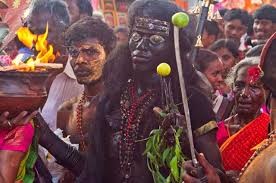
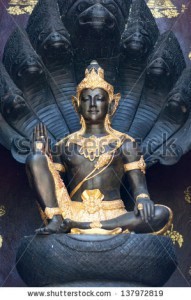
Isis, Queen of the Gods/Madonna, Mother of God
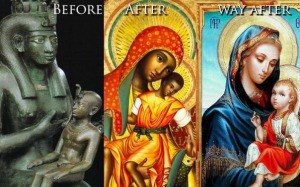
(l-r: Isis, Mary, Becky)
“All the gods and goddesses of Greece were black,” asserts Sir Godfrey Higgins, “at least this was the case with Jupiter, Baccus, Hercules, Apollo, Ammon. The goddesses Benum, Isis, Hecate, Diana, Juno, Metis, Ceres, Cybele were black.” (Anacalypsis, Vol. I, Book IV, Chap. I.) Even the Romans, who received their religion mainly from the Greeks, admitted their debt to Egypt and Ethiopia. This may be well illustrated by the following passage from The Golden Ass or Metamorphosis, by Apuleius. The author, as an initiate of the Isis cult is represented as being addressed by that goddess: “I am present; I who am Nature, the parent of things, queen of all the elements … the primitive Phrygians called me Pressimunitica, the mother or the gods; the native Athenians, Ceropian Minerva; the floating Cyprians, Paphian Venus … the inhabitants of Eleusis, the ancient goddess Ceres. Some again have invoked me as Juno, others as Bellona, others as Hecate, and others Rhamnusia; and those who are enlightened by the emerging rays of the rising sun, the Ethiopians, Ariians and Egyptians, powerful in ancient learning, who reverence by divinity with ceremonies perfectly proper, call me by my true appellation, Queen Isis.” (Doane’s Bible Myths, Note, p. 478.)
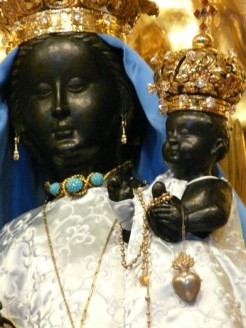
Many believe that the Black Madonnas of Europe represent vestiges of the adoration of the African goddess Ast, better known as Isis. Notre Dame Cathedral, the Cathedral of Our Lady of Paris, considered a masterpiece of Gothic architecture and at the very center of Paris, was built directly over an ancient temple of this supreme African deity. Indeed, it has been noted the name of Paris itself is derived from Park of Isis.4
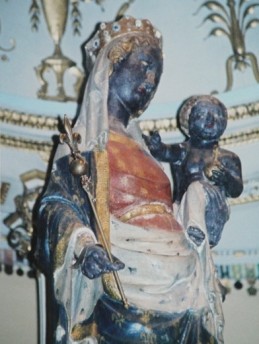
Ivan Van Sertima in “BLACK MADONNAS OF EUROPE: Diffusion of the African Isis” added:
“The Black Madonnas of Europe have a tradition which goes back hundreds of years, before the advent of Christianity. The African Isis [Aset] was prototype for the Black Madonnas of Europe. As the worship of Isis was suppressed, the Virgin Mary was elevated into the European Christendom. The African Isis was worshiped under the name of the Virgin Mary.”2
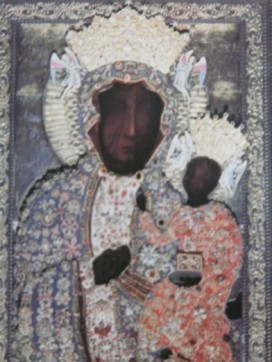
Buddhas

A study of the images of ancient deities of both the Old and New Worlds reveal their Ethiopic origin. This is noted by Kenneth R. H. Mackezie in T. A. Buckley’s Cities of the Ancient World, p. 180: “From the wooly texture of the hair, I am inclined to assign to the Buddha of India, the Fuhi of China, the Sommonacom of the Siamese, the Zaha of the Japanese, and the Quetzalcoatl of the Mexicans, the same, and indeed an African, or rather Nubian, origin.”1
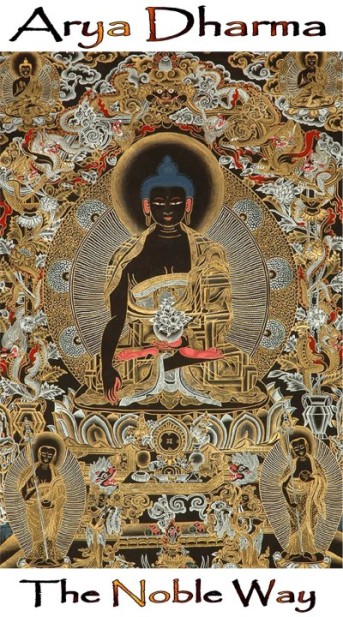
The statues of ancient Buddhas of the East depicted him as having woolly hair- always shown in corn rows or “peppercorn” texture of small tight curls.3
These statues also clearly show him to be Africoid, with the wide nose, thick lips and frizzy, nappy, hair which are distinctive Negro characteristics.3
In most ancient temples throughout Asia, he is shown as jet Black.3

In fact, in most of the ancient temples of Asia and India, statues of the gods and goddesses have Africoid features with woolly hair in the peppercorn style, while some even have dreadlocks.3
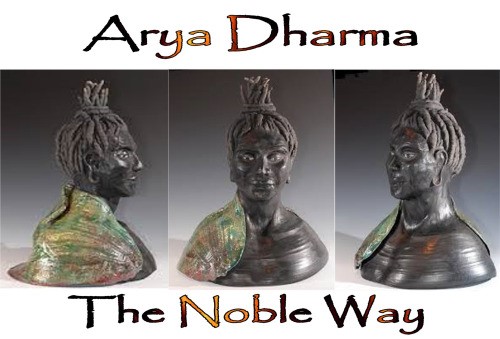
In a two-volume work entitled, “A Book of the Beginnings,” originally published in 1881, author Gerald Massey recorded:
“It is not necessary to show that the first colonizers of India were black, but it is certain that the black Buddha of India was imaged in the Africoid type. In the black [African] god, whether called Buddha or Sut-Nahsi, we have a datum. They carry in their color the proof of their origin.”2
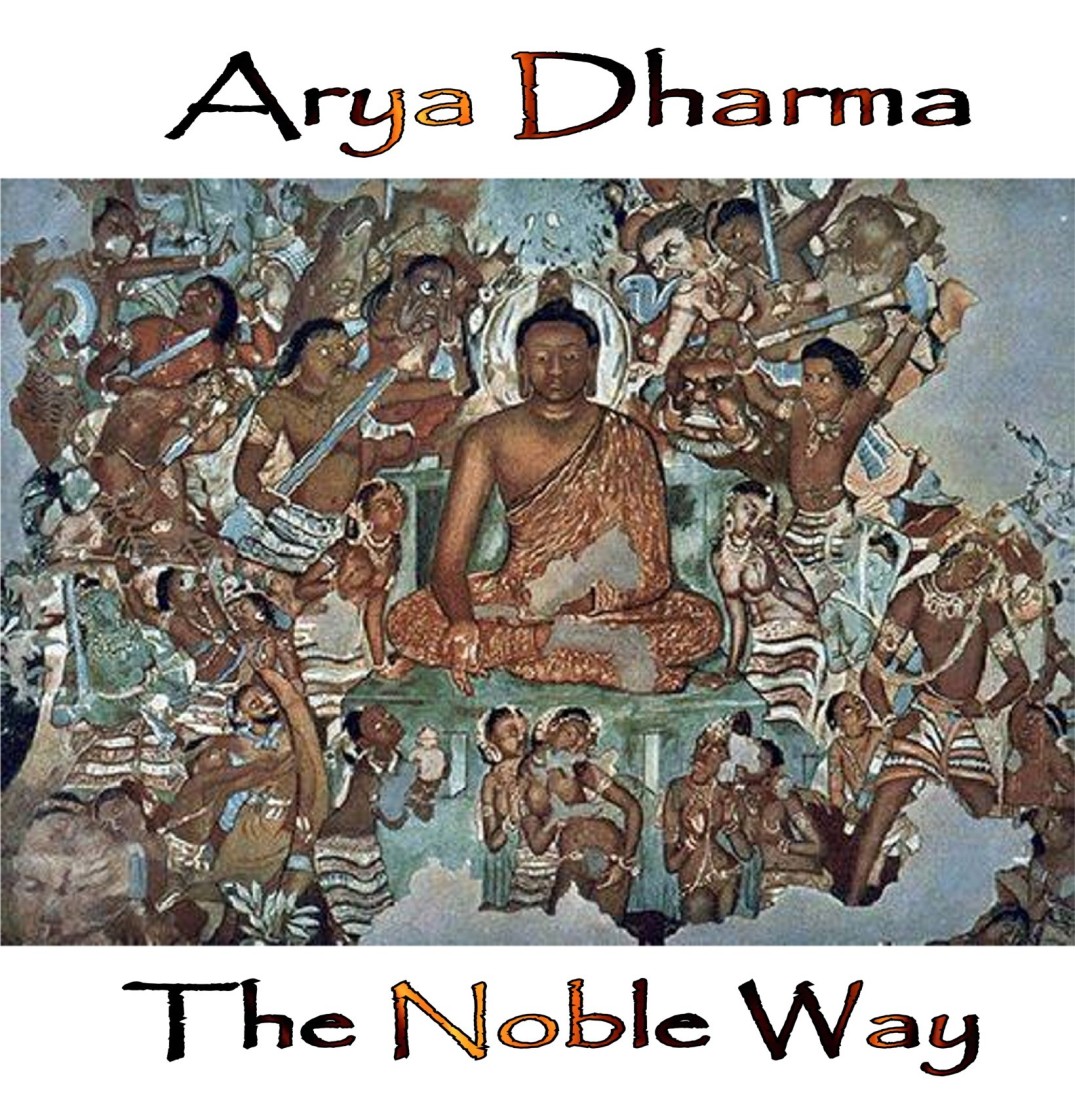
Savior/Jesus
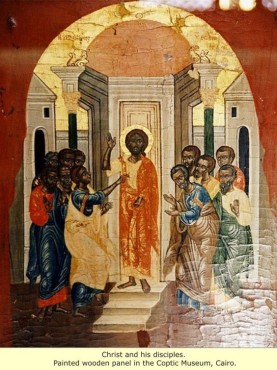
Most of these black gods were regarded as crucified saviors who died to save mankind by being nailed to a cross, or tied to a tree with arms outstretched as if on a cross, or slain violently in some other manner. Of these crucified saviors, the most prominent were Osiris and Horus of Egypt, Krishna of India, Mithra of Persia, Quetazlcoatl of Mexico, Adonis of Babylonia and Attis of Phrygia. Nearly all of these slain savior-gods have the following stories related about them: They are born of a virgin, on or near Dec. 25th (Christmas); their births are heralded by a star; they are born either in a cave or stable; they are slain, commonly by crucifixion; they descend into hell, and rise from the dead at the beginning of Spring (Easter), and finally ascend into heaven. The parallels between the legendary lives of these pagan messiahs and the life of Jesus Christ as recorded in the Bible are so similar that progressive Bible scholars now admit that stories of these heathen Christs have been woven into the life-story of Jesus. (These remarkable parallels are discussed and interpreted in a pamphlet, Christianity Before Christ, by John G. Jackson, New York, 1938.)
Jesus’ hair was short with tight curls
- Bible: “…and the hair of his head like pure wool… (Daniel 7.9)”

- Early Christian Historians: “At that time also there appeared a certain man of magic power … if it be meet to call him a man, [whose name is Jesus], whom [certain] Greeks call a son of [a] God, but his disciples [call] the true prophet who is supposed to have raised dead persons and to have cured all diseases. Both his nature and his form were human, for he was a man of simple appearance, mature age, black-skinned (melagchrous),… prognathous (lit. ‘with a long face [macroprosopos]), a long nose… with scanty & curly hair, but having a line in the middle of the head after the fashion of the Nazaraeans, with an undeveloped beard. (*Halōsis, ii.174).” (Flavius Josephus)”
- Modern Bible Scholars: “While most religious artists have put long hair on Christ, most biblical scholars believe that it was probably short with tight curls…” [3]
- Islamic Prophetic Narrations: “Jesus was a curly-haired man of moderate height.”
Jesus’ hair was also long, and parted at the middle
- Early Christian Historians: “with scanty, curly* hair [1], but having a line in the middle of the head”
- Islamic Prophetic Narrations: “I saw in my dream a man of brown color the best one can see amongst brown color and his hair was long that it fell between his shoulders. His hair was lank and water was dribbling from his head and he was placing his hands on the shoulders of two men while circumambulating the Kaba. I asked, ‘Who is this?’ They replied, ‘This is Jesus, son of Mary.’” (Prophet Muhammad)
“No, By Allah, the Prophet did not tell that Jesus was of red complexion but said, “While I was asleep circumambulating the Ka’ba (in my dream), suddenly I saw a man of brown complexion and lank hair walking between two men, and water was dropping from his head. I asked, ‘Who is this?’ The people said, ‘He is the son of Mary.’ Then I looked behind and I saw a red-complexioned, fat, curly-haired man, blind in the right eye which looked like a bulging out grape. I asked, ‘Who is this?’ They replied, ‘He is Ad-Dajjal.’”
* Note the juxtaposition of the Messiah and False Messiah, both important to Islamic and Christian eschatology.
Which kind of hair did he have: Tightly-Curled or Long?
Indeed both.
How can the same man have both short, tightly-curled or wooly hair, and also long, lank hair?
The answer is that these are describing different stages of (“dread”)locked hair, specifically those of an African.
Wool & Locked Hair
Wool compares favorably in appearance to (“dread”)locks:
Scanty, Short, and Curly Hair & Short Locked Hair
Only the hair of Sub-Saharan (“black”) Africans, and others like Andamanese Islanders and aboriginal Southeast Asians (“Negritos”, Orang Asli) is (tightly) curled or ‘woolly’ when it is short. It also appears scanty or thin because of the parting of the hair into small knots (also known as ‘peppercorn’ hair texture):
These compare favorably with early depictions of Jesus Christ:
Long Hair that can be Scant & Tightly-Curled while Short
The locked hair of an African (or others with “Negroid”/“Africoid” features) is the only type of hair that can be both short and curly, and long hair. Short locks are initially spread apart (‘scanty’) and tightly-curled, but after growing, their weight causes them to be long and limp (‘lanky’).

Jesus was a Dreadlocked African(-Diasporan)
Thus, the seeming contradiction is solved: Jesus was a (“dread”)locked African(-diasporan). His hair was sparse and tightly curled when short, and long and lank once it had grown into locks. These are descriptions of different stages of his locked hair.
African(-diasporan) males compare favorably with phenotypical features common to Christian and Islamic sources, and also with those unique to each:
- Common to both:
- Brown skin
- Woolly hair
- Hair that is tightly curled when short
- Hair that can be parted in the middle when long
- Christian only:
- Prognathous (having a projecting lower jaw or chin- common among many Sub-Saharan Africans)
- An undeveloped beard (Many Sub-Saharan Africans do not grow full beards)
- Islamic only
- Shoulder-length air that can drip lots of water

Lastly, the peculiar Islamic description of copious water drops will be addressed in brief. This can’t be a description of long hair of thin strands, because that hair lays flat when wet, and droplet dribble down the back of the person, but could only drop from his or her head if they shook it violently.
Wet Asiatic Hair

Locks on the other hand, absorb copious amounts of water, and can drip visible droplets for quite some time.5
Wet Locked Hair
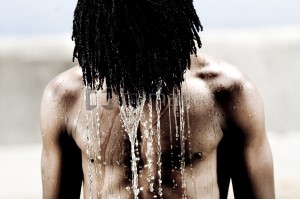
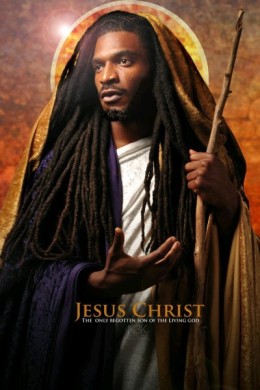
—
1 Jackson, John G. “Ethiopia and the Origin of Civilization” (1939); Retrieved 17.12.2014 from http://2017blackart.wordpress.com/2009/11/01/ethiopia-and-the-origin-of-civilization-by-john-g-jackson/
2 Tracy. “5 Black Gods Whitewashed in Recent History”. Atlanta Blackstar. 25.09.2013. http://atlantablackstar.com/2013/09/25/black-gods/
3 Horus. “Ancient Black Buddha”. Nairaland. http://www.nairaland.com/68677/ancient-black-buddha
4 Rashidi, Runoko. “The Black Madonnas Of Europe: Miracle Workers and Holy Icons”. Atlanta Blackstar. 26.03.2014. http://atlantablackstar.com/2014/03/26/black-madonnas-europe-miracle-workers-holy-icons/
5 Oliver, Daniel. “Jesus with Dreadlocks: an illustrated guide to Christian and Islamic descriptions of the Messiah”. qãhırıï. 02.05.2015. https://qahiri.wordpress.com/2015/05/02/jesus-with-dreadlocks-an-illustrated-guide-to-christian-and-islamic-descriptions-of-the-messiah/












The greatest deception of our civilization?
You can find characters of various colors in ancient indian literatures. It was clearly a mixed race and there was some type of global civilization. Sharmista the daughter of asura chief is mentioned as fairest skin. Pandu was very pale. Arjuna was black skinned. Vaivasvata, Yama, Shani were black. Kubera was white and he is mentioned as from some snowy place. Many references of various skin colors are there in extensive literatures.
Reblogged this on Black History & Culture.
Black is Power!!…. We are Gods not Slaves !!
Viral News http://viralmula.Com